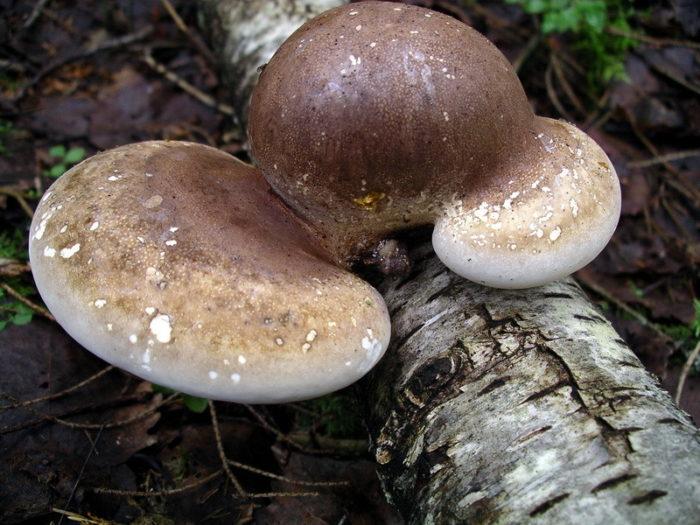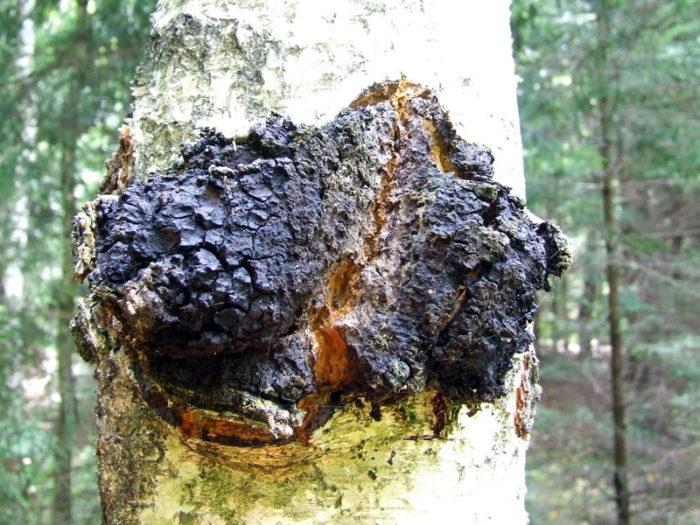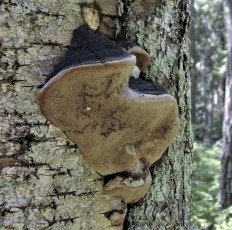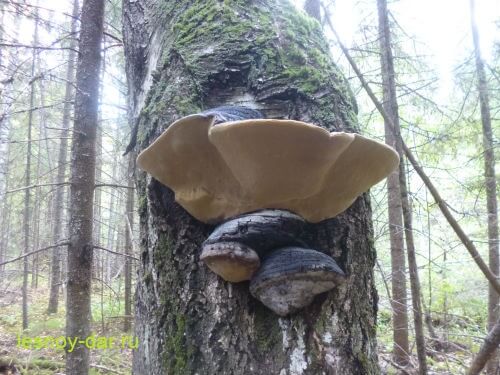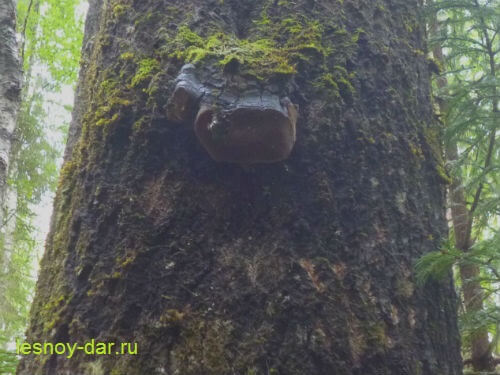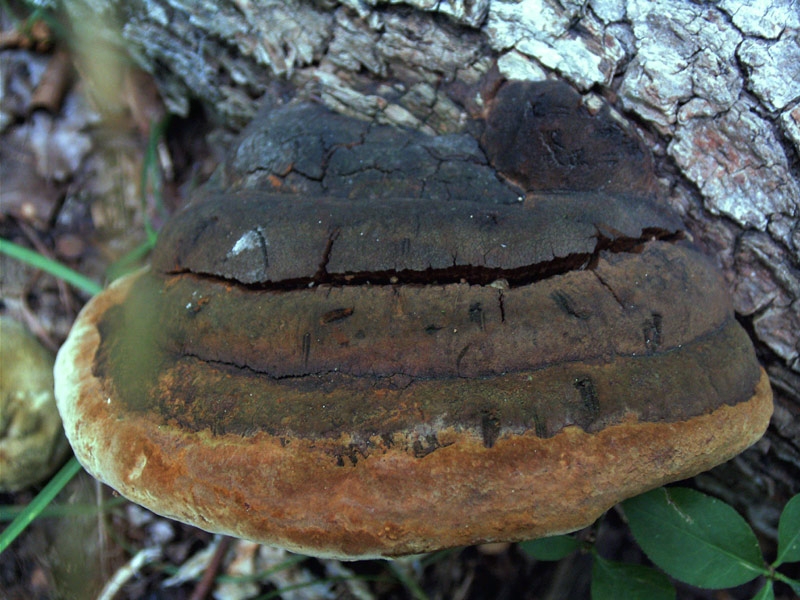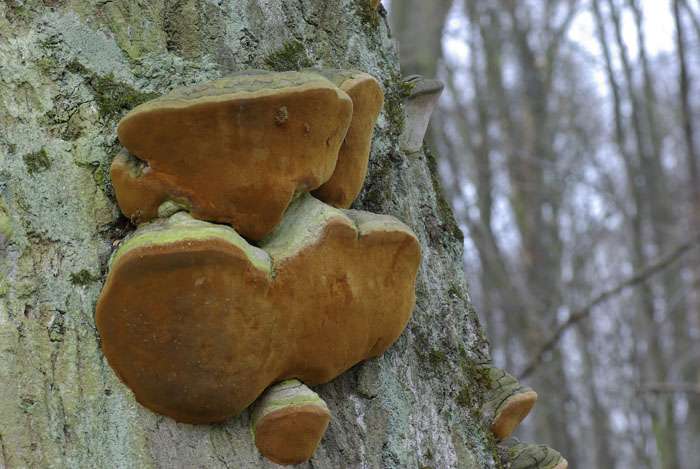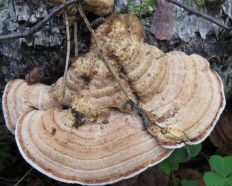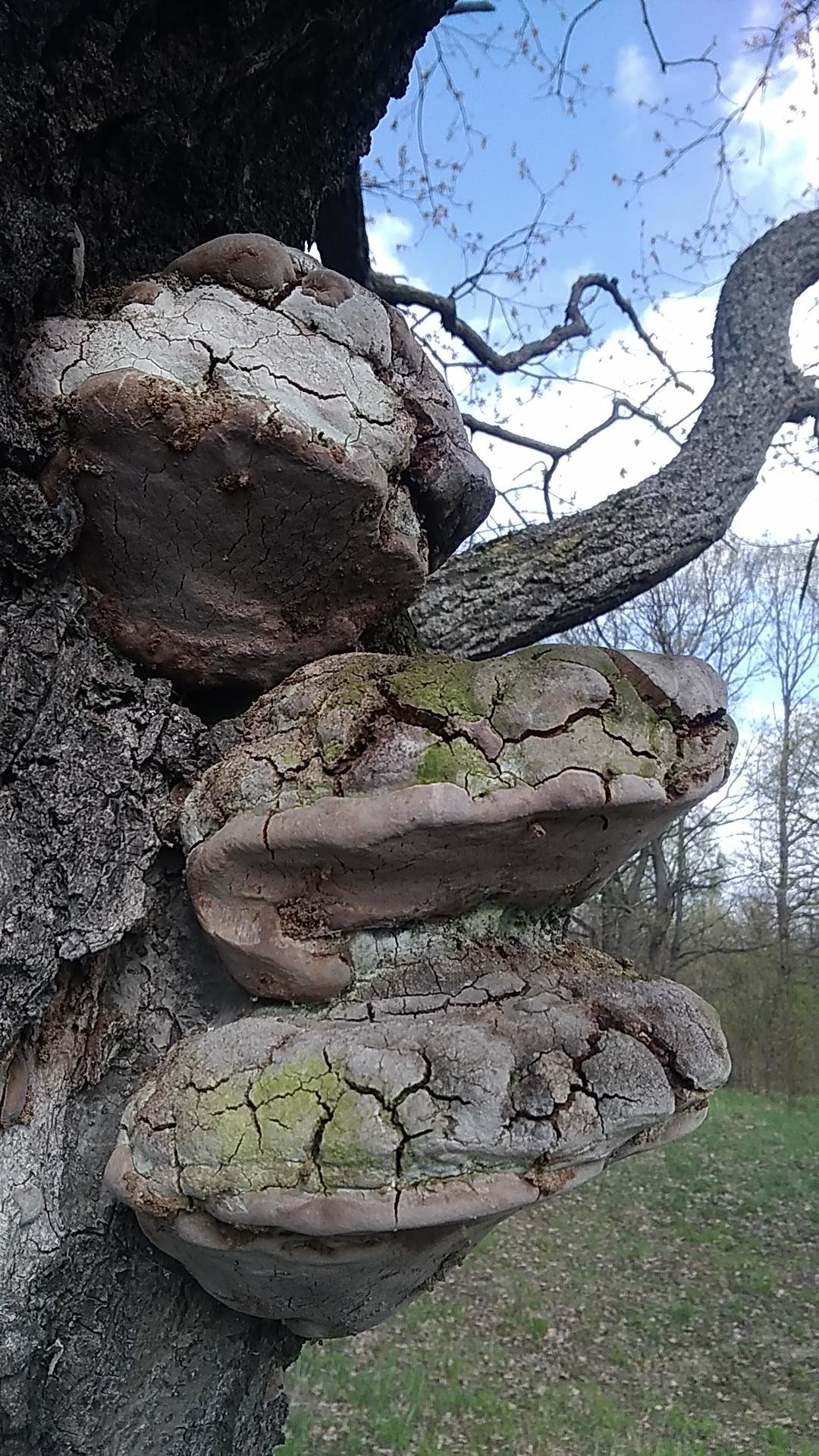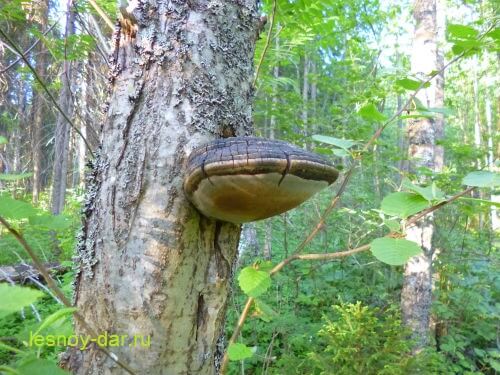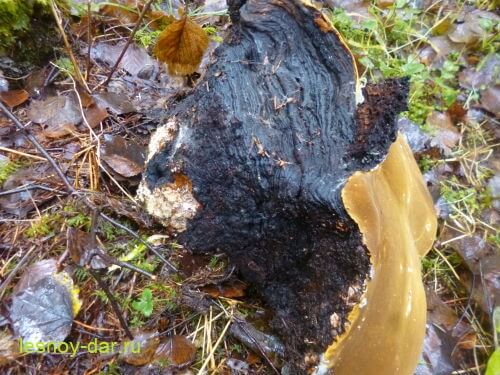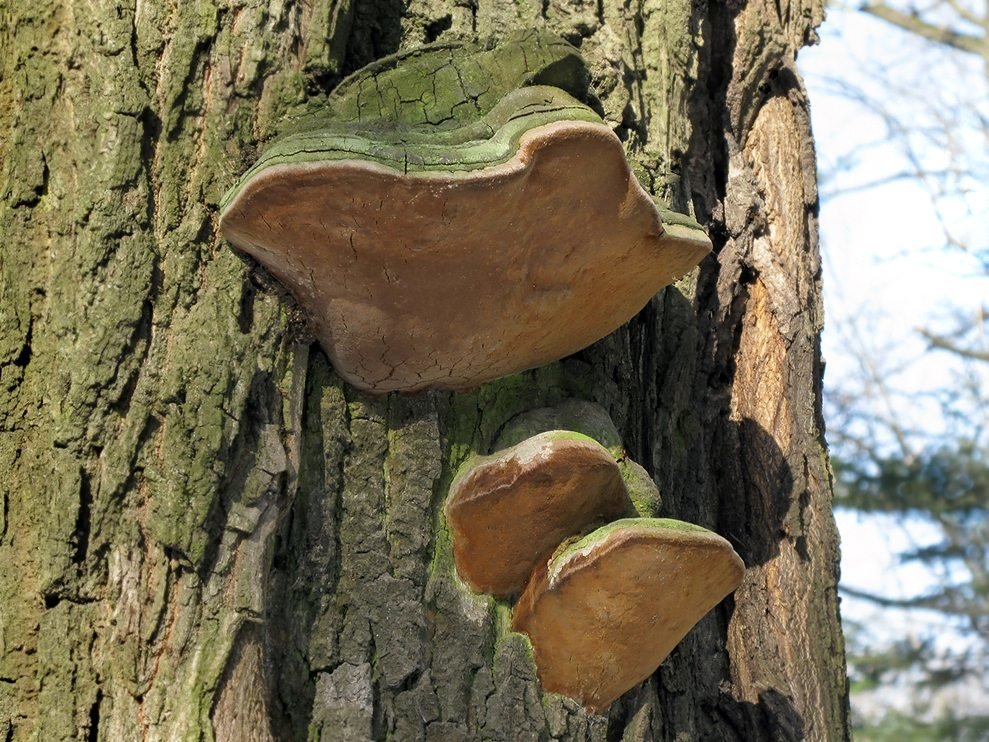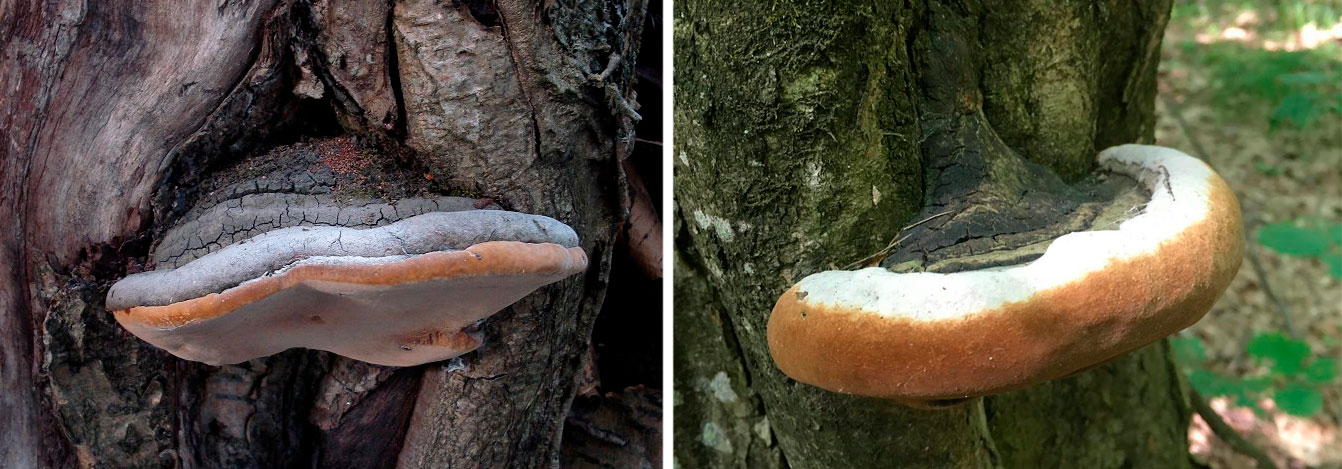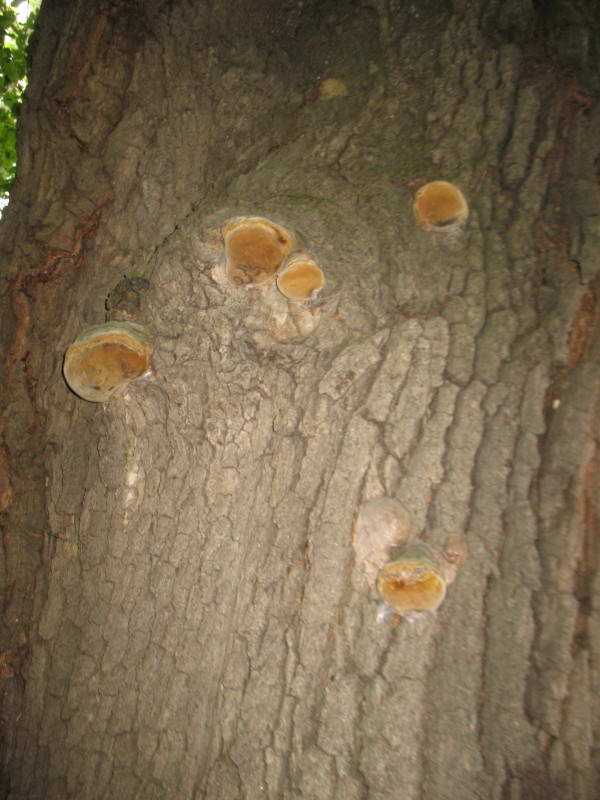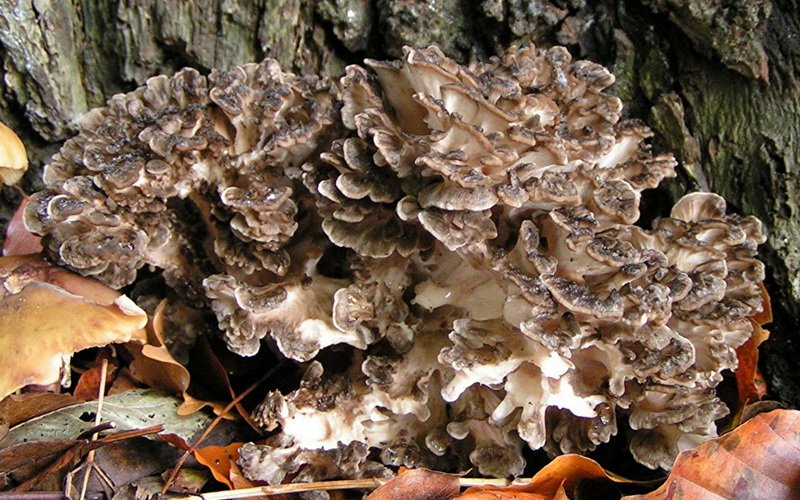Stages of development
False tinder fungus, like other species, grows not only in Russia, but also in Europe. It can be found both on living and already dead trees. In this case, the damage is foci. Infection of living trees occurs in places of damage to the bark and when spores of the fungus enter the cracks. When the decay process is just beginning, the wood takes on a brown color. After that, light yellow spots are formed. In subsequent stages, black lines appear on yellowish and off-white areas of rot.
Even someone who is not well versed in mushrooms knows that certain mushrooms can be eaten, and some of them are inedible. There are even representatives of the mushroom kingdom that are extremely harmful. When they grow on a tree, it rots. These types include the false tinder fungus, which can live up to 80 years. This mushroom is very widespread and can be seen quite often in the forests of our country.
general characteristics
This mushroom is long-lived and is found in areas where there are many trees. For them, this is a real mortal enemy. As it grows, it causes the formation of white rot. If a tree is infected with such a fungus, then it will die pretty quickly. This happens because a false tinderpop appeared on the tree, which, by the way, is not difficult to determine the age of. Each year, a new layer appears on the bottom of the mushroom. It is almost impossible to separate them, but they are easy to count.
Unlike the real tinder fungus, the surface of the false species is riddled with cracks. They are quite profound. This species belongs to polyporous fungi. Most of them are inedible. Such a representative belongs to the genus fellinus, which has several species, for example, the pine sponge, which includes the false pine tinder fungus.
False tinder fungi have many other names. They are also called burnt, and the people call them tree mushrooms. If you literally translate the name from Latin, you get a "cork". The variety of false tinder fungi fits into one genus, Fellinus. This name was given to these mushrooms for a reason. Indeed, in adulthood, it is somewhat reminiscent of a cork, the location of which is the bark of a tree.
Description
The surface of the mushroom is covered with a black crust. The mushroom is attached to the tree sideways. The body is round with blunt ends. The shape looks like a hemisphere or hoof. The diameter of the mushroom can be up to 25 millimeters, and in height with its growth it is 12 cm.
It is very difficult to distinguish different types of mushrooms by external signs, but you can do this by the type of tree on which it grows. Some of them prefer poplar, others - pine, other types of trees. The false tinder fungus belongs to perennial mushrooms, but it cannot be attributed to the tubular species, since the location of the tubes is the inner part of the fruit itself. One new layer is formed annually. It is represented by a hard hoof-like growth. It is characterized by significant color variability with different shades. The color can be chestnut or even cherry hues.
The mushroom is very tough, so it is not eaten. Its hardness cannot be eliminated even if it is boiled for a long time. But one should not assume that this representative is useless for people. It is widely used for medical purposes.
Characteristics of healing properties
If in the old days this mushroom, in crushed form, was used only as smoking mixtures, now it is used for medicinal purposes.Chinese folk medicine uses this mushroom for the prevention and treatment of cardiac pathology, conditions caused by liver pathology, and the prevention of oncology. But it should be said that only the mushroom that grows in Taiwan can be used to fight cancer. In addition, the mushroom can be used as a preventive measure against blood clots.
Natural prevalence
It is quite widespread in European countries and on the territory of our country. The place of its growth is deciduous and coniferous forests. Most often it can be seen on the trunk of a birch tree. It can appear not only on a sick, decaying tree. It is likely that it will appear on healthy trees as well. In addition, he prefers to grow on stumps, in dead wood. More often it is characterized by a single growth, but it is not uncommon to find couples. Fruit formation is observed during the warmest season. It starts in May and ends in December.
Description and photo of lacquered tinder fungus
Lacquered polypore, scientific name Ganoderma lucidum, Reishi mushroom, lingzhi belong to the department of Basidiomycot, the Ganadermaceae family. In essence, it is a parasitic fungus that grows well on sick or dying trees. Prefers to settle on deciduous trees: oak, beech, hornbeam, birch, alder. Occasionally it can be found on conifers.

Fruiting body
The fruiting body of the fungus is annual, less often 2-3 years old, with a cap-pectoralis. The cap is reniform or ovoid, almost flat. The dimensions of medium specimens reach 30-80 × 100-250 × 20-30 mm.
The surface of the cap is glossy, as if varnished, but uneven. The edges are pointed, wavy, slightly bent downwards. From the stem to the edge, the color gradually fades. The visible side of the fruiting body is divided into growth rings. The color can range from reddish to dirty purple, sometimes even black, with a faint yellow tinge. The color of the fruiting body directly depends on the type of the substrate on which it grows.
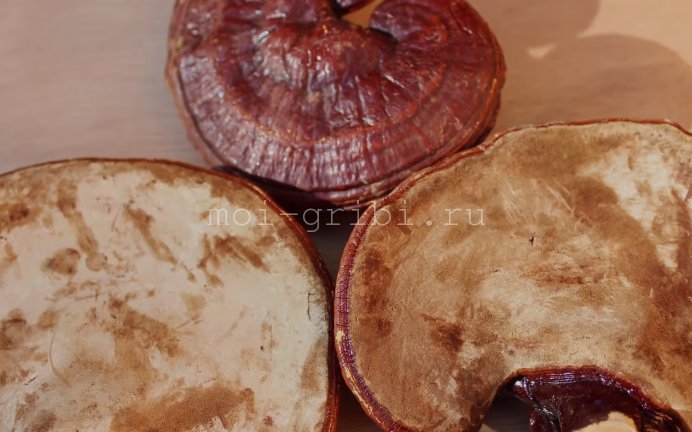
The pulp of the mushroom is dense, woody, without any special smell or taste. The inner surface of the fungus, hymenophore, tubular type, with tiny ocher-colored short tubes. The pulp darkens as it matures, coarsens and gives off a brown spore powder.

Leg
The leg of the mushroom is lateral, slightly less often central, cylindrical in shape. The surface is uneven brown, also shiny. The content of the leg is dense, dryish, corky. The length of the leg can reach 25 cm, but more often it does not exceed 5-15 cm. The diameter is 2-5 cm.
Edibility
Ganoderma varnished is not used for food. Since the end of the XVIII century, it has been cultivated in Southeast Asia exclusively for medicinal purposes, as described in the ancient medical treatises of China, Korea, and Japan. Cultivation technology - submerged cultivation.
Taxonomy, characteristics and description of the structure of the parasitic fungus
The real polypore is sometimes also called a blood sponge, it bears the Latin name Fomes fomentarius, there are also synonyms: Polyporus fomentarius, Boletus fomentarius, Ungulina fomentaria, Fomes griseus. Belongs to the genus Fomes of the polyporous family.
Sessile mushrooms, without a stem. The cap in young specimens is rounded, then becomes hoof-like. Attached to the tree by the center of the upper part. The mushroom is perennial, reaches a diameter of 40 cm, and can be up to 20 cm high. The surface is matte, stepped, with rollers. Sometimes covered with small cracks. The color ranges from light gray to dark, with occasional beige tints.
The hymenophore, the lower part of the cap, consists of tubes, the pores of which are rather large and light. Darken when pressed. Spores are white.
The pulp is very dense, tough, cork-like, often woody. The cut is usually velvety and does not change the shade. The color is brown or reddish brown.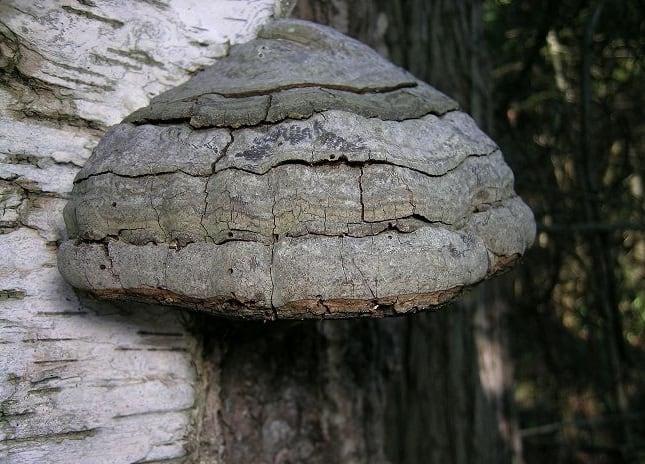
A bit of history
The first mention of this mushroom belongs to the Swedish scientist, naturalist and physician, Karl Linnaeus.He described the tinder fungus at the beginning of the 18th century, but in 1849 compatriot Elias Magnus Fries changed the genus of this species.
Description of tinder fungus changeable
Fruiting bodies of variable tinder fungi are small. The diameter of the cap is no more than 5 centimeters. The edges of the cap are initially tucked up, but over time they open up, and a deep depression remains in the center. The hat is fleshy, dense, but at the same time its edges are thin. Its surface is smooth. The color of the cap is ocher or yellowish brown. In mature specimens, caps are fibrous, fading. After rain, the cap becomes shiny and smooth, sometimes radial stripes stand out.
The pulp is leathery, elastic. The pulp has a pleasant aroma, mushroom tubules are light ocher in color, they run down from the cap to the leg. The tubular layer is very fine. Spore powder is white. The pores are cylindrical, smooth, transparent.
The knife is quite long and thin - its height reaches 7 centimeters, and its width does not exceed 8 millimeters. Most often it is placed in the center of the cap. The leg is straight in shape; in the upper part it expands slightly. Its surface is velvety. The color of the leg is dark brown or black. A velvety zone is clearly visible at the base. The stem is fibrous and dense in structure.
Places of growth and fruiting time of variable tinder fungi
These fungi develop on thin fallen branches, stumps and remains of deciduous trees. Mostly they prefer to settle on a beech. They are found in forests of various types. Fruiting time is mid-summer - mid-autumn. Tinder fungi are widespread in places.
Similarity of tinder fungus mutable with other mushrooms
For beginners, all polypores look about the same. Although this species is called variable, it has a fairly large number of distinguishing characteristics due to which it can be recognized. For example, such a feature is a black color of the leg, a white tubular layer and small pores.
The tinder fungus can be confused with the chestnut tinder fungus, but it is also inedible. However, chestnut tinder fungi are distinguished by larger sizes of fruit bodies and glossy legs.
Kindred
Birch sponge or birch tinder fungus is an inedible mushroom. The fruit body of the birch tinder fungus is sessile, without a leg. Its shape is flattened, reniform. The diameter is large, it can reach 20 centimeters. The pulp has a well-defined mushroom aroma.
Birch tinder fungi grow singly or in small clusters. Places of growth are dead wood. They also live on living, but sick trees. The mycelium causes the wood to rot. The wood begins to decay quickly and dust remains from it. These are annual mushrooms that bear fruit in late summer. These tinder fungi are not eaten because of the tough pulp and bitterness.
False oak tinder fungus is an inedible mushroom. The diameter of the fruit body of the false oak tinder fungus is 5-20 centimeters. At first it looks like a kidney, then it becomes spherical. These mushrooms are thick, sessile, attached to trees sideways. Above there are concentric irregular grooves. The color of the mushroom is gray-brown and can be black-brown. The pulp is tough, woody.
These are perennial mushrooms. They bear fruit from spring to autumn. False oak polypores parasitize living oaks, and after the death of the tree they continue to live on dead wood. Cause the development of white rot. They are found singly or in small groups.
Tinder fungi real and winter
The tinder is real. Fruiting bodies up to 80 cm in diameter and up to 20-30 cm thick, perennial, hoof-like, often flat or, conversely, with a convex, almost hemispherical top, sometimes slightly elongated and almost conically narrowed upwards.
The surface of the present tinder fungus with concentric grooves, usually rather deep, at first soft-velvety-fleecy, then naked, almost smooth, in most cases gray to dark gray and blackish, less often reddish-pale brownish to dark gray-brown, edge dull, sometimes thick, grayish-reddish, thinly pubescent. The fabric is reddish brown. The tubular layer is whitish, grayish, later grayish-red. Spore powder is white. Spores 14-24 × 5-8 µm, oblong-ellipsoid, smooth, colorless.
Growth.The real tinder fungus grows throughout the year on stumps, dead wood and dead wood, occasionally on live weakened deciduous trees, mainly beech, birch, alder, poplar.
One of the most common mushrooms in the forests of Eastern Europe. Causes light yellow heart rot with black lines and dashes. Rotting caused by the fungus is active and leads rather quickly to the destruction of wood in the direction from the sapwood to the heartwood.
Winter polypore. The cap is 1-10 cm in diameter, covered with short hairs, naked with age, rough, sometimes indistinctly scaly, brownish, often with a yellowish tinge, with a fringed and later bare edge. Stem 1–3.6 × 0.2–0.5 cm, eccentric, lateral, occasionally central, glabrous, monochromatic with a cap, black at the base. The tubular layer is whitish or straw-yellow, brownish when dry. The pulp is white. Spores 7-9 × 3-4 µm, ellipsoidal, fusiform, smooth, colorless.
Growth. Winter tinder fungus grows on branches, stumps, trunks of deciduous trees saprotrophically.
Fruiting. Appears mainly in autumn, winters, and siorulates in spring.
Usage. Young fruiting bodies of this species of tinder fungus are edible.
Further you can familiarize yourself with the photo and description of scaly and varnished tinder fungi.
Views
There are more than 1.5 thousand species of polypores, here are some of them:
Larch (real)
Found on larch, cedar and fir. It is distinguished by a thick fruiting body up to 30 cm long, yellow or white, with a rough surface, rounded edges, furrows and brown areas. It is soft at first, but later becomes hard and crumbly. This mushroom tastes bitter. In the past, such a mushroom served as a raw material for obtaining tinder. Often grows on dead deciduous trees and dead. Larch tinder fungus is discussed in detail in another article.
Flat
Such a mushroom has flat caps up to 50 cm in diameter, on which there are uneven nodules and a brown matte crust. It is found mainly on birches (less often on conifers) - on dead wood and stumps.
Lacquered (Reishi)
It is distinguished by a reddish-brown shiny cap, the presence of a leg and healing properties. Another name such a tinder fungus is reishi. Read more about it in another article.
Umbrella
It has flat, light, rounded caps, depressed in the center, collected in large fruiting bodies up to 40 cm in diameter and weighing up to 4 kg. This is a very rare tinder fungus, noted in the Red Book.

Sulfur yellow
The peculiarities of this type of tinder fungus is the yellow-orange color of its fruit chalk. The diameter of such a mushroom reaches 50 cm. It grows on weakened or dead trees in gardens, parks and forests.

Winter
Differs in flat-convex yellow-brown caps, firm gray-yellow legs, elastic flesh. Grows on roots, stumps and trunks of deciduous trees. Fruiting from May to December. Edible when young.

Bristly
A feature of such a tinder fungus is a triangular section of fruit chalk. The young fungus is spongy and moist, but later dries up and becomes hard. The diameter of the fruiting body of such a tinder fungus is up to 25 cm, the height is up to 35 cm.
Chestnut
Mushroom up to 10 cm high with funnel-shaped light caps with wavy edges and firm legs tapering towards the base. It grows on dead wood and stumps in damp places.
Haired
Such tinder fungi have semicircular sessile caps covered with hard gray hairs about 5 mm long, growing vertically in bunches. This species is found on deciduous trees - on trunks, deadwood, branches and stumps. Occasionally grows on wooden structures and fences.
Birch
A mushroom with a smooth whitish surface, spherical fruiting bodies and white pulp, which has a pronounced mushroom smell and a bitter taste. This tinder fungus grows only on birches.At an early age, it can be eaten. This tinder fungus contains polyporenic acid, which has anti-inflammatory activity.
Radiant
It is distinguished by annual semicircular flat bodies with a wrinkled surface of a yellow-orange hue (later brown), which grow in rows or tiers on dead and live hornbeams, aspens, lindens, birches and other trees.
Multicolored
A feature of such a tinder fungus is the velvety surface of fruit bodies with concentric zones of different colors - from yellow to brownish-blue. This mushroom grows in groups on stumps and dead trees (usually deciduous).
Scaly
Such a mushroom has spread light fleshy caps up to 30 cm in diameter, elastic dense flesh, as well as eccentrically located legs. Such tinder fungus grows in parks and forests on weakened and living trees (often on elms).
Cinnabar red
Differs in annual hoof-shaped fruiting bodies up to 10 cm in diameter with a bumpy red surface and red flesh. Found on decaying and weakened deciduous trees.

Odorous
The peculiarity of this tinder fungus is the aniseed aroma of its rusty-brown fruiting body. Such a mushroom often grows on deadwood and stumps of coniferous trees.
The Tinder fungus has certain medicinal properties. The scope of their application is different, but one follows from the other. Below are descriptions of the different types of tinder fungus and its healing effects.
Features of the tinder fungus
Polypore consists of mycelium and fruiting body, which are formed by thin transparent filaments. A significant part is located directly in the body of the fungus, and only reproductive organs (spores) are located outside. Although the parasite's hyphae do not appear on wood by force, but through the release of enzymes that gradually dissolve the cell membranes of the stem surface. Later, cracks appear in the bark of the tree, where spores settle, and after the spread of the mycelium, the remaining fragments of the fruiting body of the tinder fungus appear.
Description and photo
Visually, the tinder fungus resembles the bottom of an inverted saucer, which has partially grown into the trunk. The size of the caps ranges from 10 to 40 cm, and the maximum thickness is observed in the zone of contact with the tree trunk - about 7 cm. And the mass of a whole mushroom can vary within 8-10 kg. The edge of the body looks slightly wavy and is divided into lobes by deepened cracks. There is a light fluff along the entire cap. The surface itself is smooth, covered with a thick crust of white, smoky, brown or brownish-yellow shades. The older the mushroom, the darker the rind becomes, reaching an almost black color.
The structure of the tinder fungus pulp directly depends on the typology of the fungus. It is usually hard, woody with a yellow-brown color and a slight fruity aroma. The pores of the fungus are represented by rounded tubes, which are arranged in layers: every year a new layer 5 mm thick grows on top. Fresh pores have a light gray color, but over time they acquire a yellow-gray scale, and when pressed, they are generally brown.
Features of cooking mashed tomatoes
Servings: 8-10
Ingredients:
- Tomatoes - 10 kilograms
- Carrots - 500 grams
- Onions - 1 large onion
- Celery - 1 small bunch
- Fresh parsley - 1 small bunch
- Sugar sand and salt - according to your taste
- Lemon juice - 1 tablespoon
- For tomato juice to turn out great, you should take care of the main ingredient - tomatoes. Choose only the juicy and ripe tomatoes.
- Prepare all the main ingredients: rinse the tomatoes and fresh herbs thoroughly, peel the onions and carrots.
- Dry the tomatoes a little, and then remove the stalks, and cut the fruits themselves into 4 parts. Place the chopped tomatoes in a large saucepan and then remember them with a pusher. You can also use a hand blender or meat grinder and chop the tomatoes until smooth.
- Cut the onion in half and then cut each half into small cubes. Also cut the carrots into thin slices. Add the onions and carrots to the tomato puree.
- Finely chop the washed and dried celery and parsley. Add to the pan with the rest of the vegetables and mix well.
- Put a saucepan with vegetable puree on high heat, bring its contents to a boil, then reduce heat and simmer vegetables over low heat for about 30-35 minutes. Try the juice for the presence of salt and sugar, and if it seemed to you that the juice is sweetish, you can add 1 tablespoon of lemon juice (based on 1 liter of tomato juice). Lemon will give the drink an unusual flavor and aroma.
- Then gently rub the vegetable puree through a fine sieve to separate the juice from the pulp.
- Prepare seaming jars: rinse and sterilize in a water bath for 5-10 minutes.
- Pour hot tomato juice into prepared dry jars and cover with tin lids.
- It remains to sterilize the juice cans in a pot of boiling water for half an hour, and then seal with lids.
- After cooling down, move the tomato juice cans to a cool place.
Ingredients:
- Tomatoes - 2 kilograms
- Table salt - 50 grams
- Sugar - 1 kilogram
- Allspice - 40 peas
- Ground pepper (red) - 1.5 teaspoons
- Cloves in buds - 10 pieces
- Cinnamon - 2-3 teaspoons
- Table vinegar 9% - 50 milliliters
- Garlic - 3-4 cloves
- Nutmeg - on the tip of a knife
- Rinse the tomatoes, remove the stalk attachment point and cut into 2-4 pieces. Pass the prepared tomatoes through a meat grinder.
- It is best to use a meat grinder with a special attachment that collects the cake. If you don't have one, strain the resulting tomato puree through a fine sieve. This way you get pure tomato juice without the skin.
- Pour the juice into a saucepan and put it on fire. When the juice boils, reduce the heat to the minimum. Simmer the tomato juice on a low boil for about half an hour.
- After the juice has boiled, add sugar (the amount can be adjusted depending on your taste), salt, vinegar, cinnamon, cloves, allspice and ground peppers.
- Peel and chop the garlic with a garlic press and add to boiling tomato juice.
- Let the juice simmer for another 10-12 minutes and remove the pan from the heat.
- Gently pour the juice into previously prepared sterilized jars and seal with lids.
- Turn the finished jars, lids down, and then cover them with a blanket and leave until the jars of juice have completely cooled.
- That's all: a tasty, healthy and aromatic drink is ready! Enjoy your meal!
By twisting the tomatoes in a meat grinder, you can cook ketchups, adjika or other preparations. This method allows you to preserve the natural taste and aroma of tomatoes.
general characteristics
This mushroom is long-lived and is found in areas where there are many trees. For them, this is a real mortal enemy. As it grows, it causes the formation of white rot. If a tree is infected with such a fungus, then it will die pretty quickly. This happens because a false tinderpop appeared on the tree, which, by the way, is not difficult to determine the age of. Each year, a new layer appears on the bottom of the mushroom. It is almost impossible to separate them, but they are easy to count.
Unlike the real tinder fungus, the surface of the false species is riddled with cracks. They are quite profound. This species belongs to polyporous fungi. Most of them are inedible. Such a representative belongs to the genus fellinus, which has several species, for example, the pine sponge, which includes the false pine tinder fungus.
False tinder fungi have many other names. They are also called burnt, and the people call them tree mushrooms. If you literally translate the name from Latin, you get a "cork". The variety of false tinder fungi fits into one genus, Fellinus. This name was given to these mushrooms for a reason.Indeed, in adulthood, it is somewhat reminiscent of a cork, the location of which is the bark of a tree.


